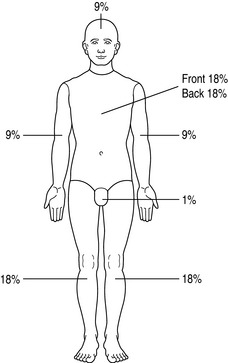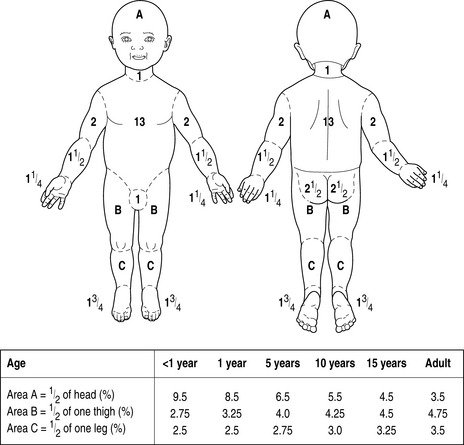Chapter 73 Burns
The last half of the twentieth century witnessed a sustained improvement in the survival of patients suffering thermal injury. Arguably, the single most important development has been the establishment of centralised burn care which made possible advances in fluid resuscitation, life support techniques and the prevention of infection. With optimal care, children and young adults with burns of more than 80% of total body surface area (TBSA) now stand a reasonable chance of survival.1
Improvements in survival have gradually led to a shift of emphasis in burn care towards qualitative aspects, such as rehabilitation and quality of life. The complexity of care has led to the concept of the multidisciplinary burn team, in which all aspects of care are coordinated in an integrated approach to clinical management.1
PATHOPHYSIOLOGY
LOCAL EFFECTS
Thermal injury produces complex local and systemic responses. The local inflammatory response results in vasodilatation and an increase in vascular permeability. The changes are immediate and combine to produce extravasation of fluid and plasma protein at the site of injury. In extensive burns, oedema becomes generalised. The greatest rate of oedema formation occurs in the first few hours, but further extravasation occurs up to 24 hours post burn.2 The total amount of oedema formed depends on the extent of injury and the volume and rate of fluid administration. Without fluid replacement, hypovolaemic shock occurs, limiting the extent of extravasation. On the other hand, excessive fluid administration will produce excessive oedema. By 24 hours post burn, oedema formation is largely complete and vascular integrity restored.
CIRCULATORY EFFECTS
Circulatory effects of burn injury become significant in burns of over 15% TBSA. Changes are rapid and the magnitude is roughly proportional to the extent of burn injury. Cardiac output is reduced immediately following injury. Secretion of adrenaline (epinephrine), noradrenaline (norepinephrine), vasopressin and angiotensin cause an increase in systemic and pulmonary vascular resistance. Circulating levels of agents with myocardial depressant properties, such as interleukin-1 and TNF-α, are increased following burn injury, but developing hypovolaemia and increased blood viscosity may be equally important.3
Cardiac output recovers gradually during the second post-burn day, reaching supranormal levels by day 3 as the hypermetabolic response to burn injury becomes manifest. Circulatory dynamics are complicated by resorption of oedema fluid and by continuing evaporative fluid loss from the wounds. Prolonged elevation of renin/angiotensin and antidiuretic hormone (ADH) has been well documented and circulating blood volume may remain subnormal into the second week post burn.4
METABOLIC EFFECTS
The hypermetabolic state, which ensues from around the third post-burn day until the wounds are substantially healed, is a manifestation of the systemic inflammatory response syndrome. The state is partly sustained by evaporative and radiant heat loss through the wounds, and energy expenditure can be reduced by increasing the ambient temperature and by the use of occlusive dressings.5,6 Other factors known to influence the metabolic rate include pain, fear and anxiety. There is also a suggestion that bacterial colonisation may aggravate hypermetabolism.7,8 Burn patients often develop moderate pyrexia, even when all microbial cultures are negative.
PHARMACOLOGICAL EFFECTS
The pharmacokinetics and pharmacodynamics of many drugs are markedly altered in burn patients. During the first 24 hours, when the cardiac output is depressed, absorption and distribution of administered drugs are delayed. Thereafter, increased cardiac output leads to accelerated drug absorption and distribution, while oedema fluid acts as an ill-defined third space. At the same time, renal blood flow and creatinine clearance are increased, particularly in younger patients. Drugs excreted via this route, such as the quinolone and aminoglycoside antibiotics, may therefore fail to reach effective levels at conventional dosages.9 On the other hand, toxic levels may ensue if renal failure supervenes. If possible, therefore, antibiotic administration should be guided by measurement of plasma concentrations.
Serum albumin levels are low in burn patients, and drugs bound to this protein, including some benzodiazepines, will show increased bioavailability. On the other hand, α1-glycoprotein levels, which bind fentanyl, are increased. Detoxification via redox pathways, such as cytochrome P-450, is depressed, lengthening the half-life of drugs such as diazepam.10 Accumulation of benzodiazepine derivatives may be increased.
The pharmacodynamics of muscle relaxants are significantly altered due to an increase in peri-junctional acetylcholine receptors.11 Patients become relatively insensitive to non-depolarising agents, while administration of succinylcholine may give rise to excessive release of potassium, and cardiac arrest.
CLINICAL MANAGEMENT
FIRST AID
Immediate aid comprises stopping the burn process, followed by the removal of clothing and cooling the wound, preferably with tepid, running water, for 10–20 minutes. This provides pain relief and may prevent deepening of the wound.12 Hypothermia should be avoided. Oxygen should be given, if available, and patients with burns to head and neck should be kept in a semi-upright position. Burn injury can only be assessed properly in hospital conditions, and priority should be given to early evacuation of the victim.
GENERAL MANAGEMENT: 0–24 HOURS
On admission, a careful history should be taken of the circumstances of the injury, and to elucidate past medical history. The patient should be undressed, weighed, and carefully examined to exclude additional traumatic injury. The extent and depth of injury is assessed with the aid of printed Lund and Browder charts, or by using the ‘rule of nines’ (Figure 73.1). The rule of nines is modified for children (Figure 73.2). A nasogastric tube and urinary catheter should be inserted in patients requiring resuscitation therapy. Escharotomies may be required for circular burns of the trunk and limbs.
FLUID THERAPY: 0–24 HOURS
Fluid therapy is required for injuries exceeding 15% of body surface area (10% in children and the elderly), preferably via a wide-bore peripheral i.v. cannula (preferably not in a burned area). The aim is to provide sufficient salt and water to preserve normal organ function, while minimising oedema formation. Excessive fluid administration increases the risk of circulatory overload in the days following the resuscitation period. Potentially fatal complications of excessive fluid administration include the abdominal compartment syndrome in adults13 and the occurrence of cerebral oedema in children.14 An increasing tendency in recent years to overresuscitate burn patients has been signalled.15,16 In contrast to other traumatic injuries, burn hypovolaemia is gradual, obligatory and predictable. Aggressive fluid administration will not restore the circulating volume17 and in the absence of frank shock, bolus fluids should not be given.
Various resuscitation formulae have been published in the past to guide initial fluid therapy. These formulae are entirely experience-based and many are of historical interest only, but all comprise a fluid intake of 2–4 ml/kg body weight per % burn in 24 hours, and a sodium intake of approximately 0.5 mmol/kg per % burn.18 These findings have led some to employ resuscitation regimens based on the administration of hypertonic sodium solutions, which require a smaller volume of fluid. However, the solute load may be excessive, requiring extra water administration in subsequent days, with an increased risk of fluid overload. The use of isotonic saline solutions is therefore preferred by those without experience of burns resuscitation.
The formula thus incorporates a faster rate of administration if initial treatment has been delayed.
Children require extra fluid to compensate for basal needs. For children under 30 kg, the resuscitation formula of Carvajal19 is useful:
Thirst is common, but unrestricted oral fluids will increase oedema formation. Controlled quantities of nutritional liquids are recommended to protect gut integrity.20 In patients with extensive injuries, tube feeding at a low rate can be commenced within a few hours of injury.
< div class='tao-gold-member'>

Full access? Get Clinical Tree









